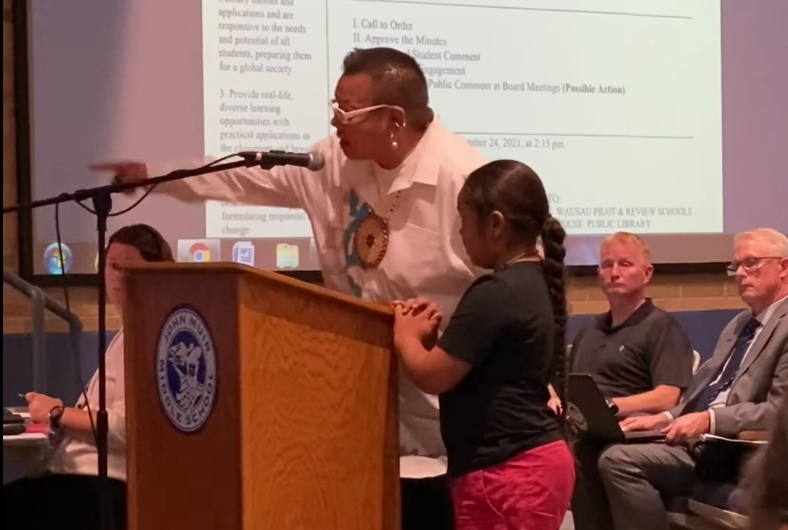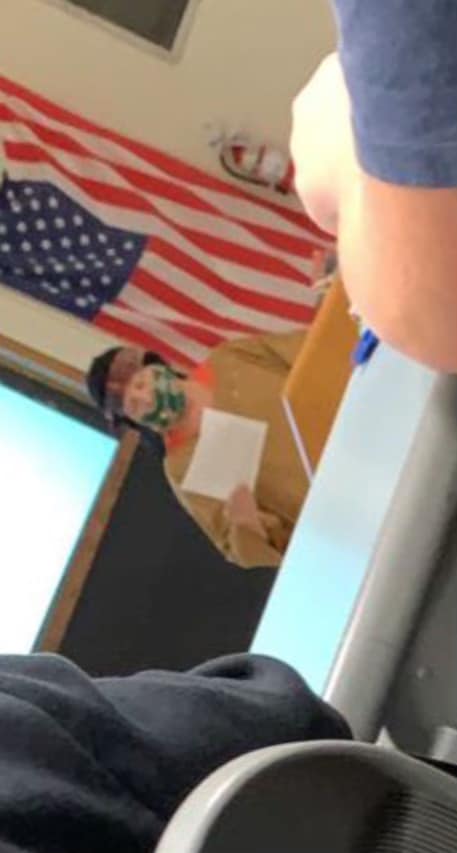
Indigenous leaders and allies are calling for changes in the Wausau School District after a history teacher dressed in a stereotypical Native American costume for a lesson on Ojibwe culture.
Biskakone Greg Johnson, a member of the Lac de Flambeau Band of Lake Superior Chippewa, posted a photo taken by his son on Facebook Wednesday depicting an unidentified teacher wearing a center-parted black wig, headband and brown tunic meant to look like buckskin.
“You can’t dress as a race of people,” said former Wausau school board president Tricia Zunker, who is also a justice on the Ho-Chunk Nation Supreme Court. “We’re not a costume.”
The district initially said in a statement that it was “reviewing a situation at one of our schools that is causing expressions of concern about cultural sensitivity.”

On Friday, the district issued an apology, including a message read to students.
“In our attempt to create a fun learning environment, we failed to recognize the disrespect we showed the culture and heritage of the people we portrayed,” the apology reads in part.
In a follow-up Facebook post, Johnson said he and his son were told the teacher had been teaching this way for 16 years but that it would stop.
“After my son said something and we brought awareness to it other parents expressed concern and frustration,” he wrote. “All it takes is one voice. And I applaud my son for risking his neck in a new school to call out blatant racism. I also am holding the word of administration to come clean to the school students and explain why you don’t play Indian. They were given direct orders from us to make this right. There’s no wiggle room. And they gladly took what we offered.”
But, he wrote, “Eyes on Wausau West. If any other schools out there are ‘playing Indian’ reel it in.”
Several Indigenous leaders held a press conference Monday ahead of the school board’s Operations Committee meeting to demand changes, and about a dozen community members spoke at the meeting to express their concerns.
Ho-Chunk Nation Vice President Karena Thundercloud said at the press conference that researchers have developed robust curriculum to teach Native American history and culture.
“There are no acceptable methods that call for dressing up like an Indian,” she said.
“I’d like to say that I’m outraged, but that would imply that somehow I’m surprised. And I’m not. I’m ashamed,” she said later at the committee meeting. “Dressing up as you think an Indian would isn’t educational. It’s racist.”
Retired social work professor Alton “Sonny” Smart said dressing in a costume can reinforce negative stereotypes.
“Perception is the biggest part of communication. People see something, and from that they perceive … and from there they go on to fill in the gaps, and a lot of times, that’s a stereotype,” he said. “Sometimes you have individuals who think that they’re helping but actually they haven’t really checked with the individuals they’re trying to help.”
Dylan Prescott, a member of the Ho-Chunk and Potawatomi Nations, brought his young son to the school board committee meeting.
“Look at this young man right here. You tell him about that (teacher). You tell him that that was right, that she could tell my son about our culture. You tell him that it was okay, because I’m not gonna,” he said. “Use your heart. Think about us as Native American people. We’re hurt. Something like this is serious to our people. This is no laughing matter. Here I only get three minutes. That woman was given a whole hour to talk that about us, wearing this garbage. I come to you right here. I’m not wearing colored feathers, I’m not wearing all that Halloween garment in front of you.”
Zunker noted that the costume wasn’t the only problem; a homework assignment included questions about “shamans,” which don’t exist in any of the Wisconsin-based nations.
“How can you be teaching about any Wisconsin tribe and have this reference to shamans? That’s just absurd,” she said. “It’s just made up. I don’t know why they would be teaching that. That’s not true.”
State data indicate that Indigenous students make up just over one-half of one percent of the student body in Wausau, but Zunker said teaching stereotypes is bad for all students.
“That type of behavior is detrimental to the learning environment of all students, not just Native students,” she said. “What are these other students being taught? What is their understanding?”
Barb Munson, chair of the Indian Mascot and Logo Task Force in the Wisconsin Indian Education Association, said research indicates that Native American stereotypes in mascots and classrooms “harms all of our students, native and non-native students.”
In an interview Monday, Zunker said she and other leaders had four specific demands of the Wausau school district: first, engage David O’Connor, the American Indian Studies Consultant at the Wisconsin Department of Public Instruction.
“He was willing to come and do whatever training. There’s so much that he can offer this district. To my knowledge, it has not been something … administrators have accepted,” Zunker said.
Second, Zunker wants the district to engage with tribal leaders to bring curriculum into compliance with Wisconsin Act 31, which requires accurate instruction regarding Wisconsin’s recognized Indigenous nations.
Third, the district should engage with the Wisconsin Indian Education Association to develop curriculum, and fourth, hire a diversity and inclusion manager.
“There isn’t one in district administration. It’s clear that that’s needed,” she said.



